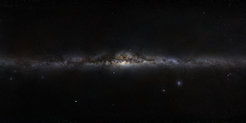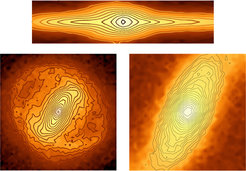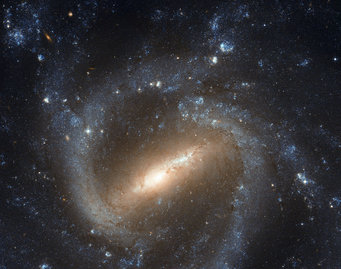The Milky Way - tomography of a barred spiral galaxy

Our Milky Way, like many other spiral galaxies, consists of a disk with spiral arms containing relatively young stars, and an elongated "bulge" in the central region with predominantly old stars. In addition, the Milky Way also contains a "bar" as do about two-thirds of all spiral galaxies (see Figure 1). This overall structure of our Galaxy has been known for some time, but it is difficult to measure the spatial distribution and properties of distant stars because our Sun and Earth are located right in the Galaxy's thin disk of gas and dust. Distant stars are therefore often hidden behind gas and dust clouds, particularly in the direction of the galactic centre at a distance of 25 000 light-years (Figure 2).
The best view of the inner Galaxy is at near-infrared wavelengths, where the clouds become transparent. Such observations of a certain class of giant stars, the so-called red clump stars, have given us the best information about the Milky Way's inner regions so far. These stars have very uniform absolute luminosity and colour, therefore their distances and the residual dimming by dust can be determined from their apparent brightness and colour. With this information, their distribution along the line of sight can be reconstructed.

Asymmetries in the distributions of these stars on both sides of the Galactic centre led astronomers to believe that the stars are arranged in a bar-like structure. The data even suggested two barred components, an inner elongated bulge, and an outer bar in the disk, with different orientations. Recent observations from the VVV survey at the ESO VISTA telescope have now shown that the asymmetries in the distributions of the red clump stars change again within about 2000 light-years from the Galactic centre. Does this imply a new nuclear bar component in the innermost Milky Way? And how could all these structures in the inner Milky Way have formed?
Using a computer simulation, scientists at the Max Planck Institute for Extraterrestrial Physics have now shown that the elongated bulge, the bar in the disk, and the distribution of stars around the centre of the Milky Way can all be explained with one and the same model, which also predicts how the bar is interacting with the spiral arms. The innermost region within 2000 light-years from the centre turns out to have higher density and rounder morphology than the cigar-shaped structure of the outer bulge (Figure 3).

"In our model, the galactic bulge is caused by dynamical instabilities in the disk," says Ortwin Gerhard, senior scientist of the research group at MPE. "Surprisingly, we could reproduce the newly discovered configuration with this model as well, without having to adjust the parameters to these observations in particular. All components, near the centre and farther out, form naturally in the evolution of a generic disk galaxy."
The simulation includes one million particles, which were initially arranged in an exponential disk and surrounded by a halo of dark matter. Over the course of 1-2 billion years instabilities develop that first lead to a bar-shaped structure and finally to a thickening in the centre, the elongated bulge. The fact that several of the structures in the Milky Way as seen from our position within the disk emerge naturally in such a simulation supports the hypothesis that our Milky Way started out as a pure disk galaxy and evolved without any large outside influence.














